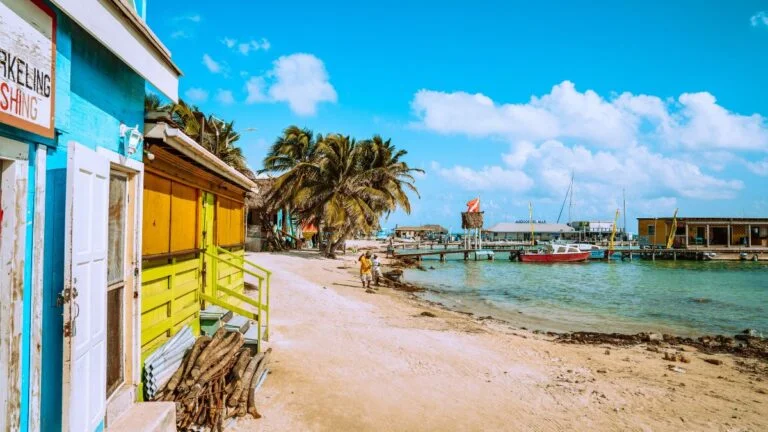Worst Time To Visit Japan: Navigating the Seasonal Pitfalls and Avoiding Tourist Traps

As participants in Amazon Associates and other programs, we earn from qualifying purchases. This comes at no additional cost to you. For more details, see our Affiliate Disclosure.
Japan, the “Land of the Rising Sun,” is renowned for its unique mix of traditional and contemporary culture, from ancient temples to technologically advanced cities. It is a country brimming with enchanting sights and experiences that attract millions of tourists each year. However, like any destination, there are less favorable times to visit.
Understanding when and why these periods may not be ideal can greatly enhance your travel plans and overall experience in Japan. This article aims to provide valuable insights into the worst times to visit Japan, shedding light on factors such as weather, crowd density, and price hikes that can affect your journey.
Understanding Japan’s Seasons: The Worst Weather to Expect
Japan experiences four distinct seasons, each bringing unique colors and climates. However, it’s crucial to understand these seasons as some bring unfavorable weather conditions that can affect your travel experience.
Winter (December to February): The winters in Japan can be harsh, especially in the northern regions like Hokkaido where heavy snowfall and freezing temperatures are commonplace. Traveling during this time can be challenging due to cold weather, potential flight disruptions, and icy road conditions. However, if you’re a snow sports enthusiast, winter is the perfect time for you.
Spring (March to May): Spring is generally considered one of the best times to visit Japan due to mild temperatures and the breathtaking cherry blossom season. However, hay fever (pollen allergy) is prevalent during this time, which could be problematic for sensitive travelers.
Summer (June to August): The early summer months, June and July, are characterized by Japan’s rainy season or ‘Tsuyu’. This can be a challenging period to travel as the heavy rainfall can often disrupt outdoor activities and travel plans. Following the rainy season, Japan experiences a scorching summer with high humidity levels, especially in cities like Tokyo and Osaka. This can be uncomfortable for those not accustomed to intense heat and humidity.
Autumn (September to November): Autumn is another favorable season to visit Japan due to its relatively mild weather and the spectacular colors of fall foliage. However, it is also the typhoon season, particularly in September and October. Typhoons can bring extreme weather conditions, including heavy rain and strong winds, potentially causing transportation delays and cancellations.
Knowing when these seasons occur and what they bring can help you decide when it’s best for you to visit Japan and what to prepare for during your trip.
Overcrowded Periods: National Holidays and Festivals to Avoid
Japan, as a country with a rich cultural heritage, hosts an array of vibrant festivals and observes several national holidays each year. While these events are a feast for the senses and offer deep insights into the country’s traditions, they often attract massive crowds, both domestic and international. Here are some of the periods that see a surge in the population and might be best avoided if you prefer a more serene experience.
Golden Week (Late April to Early May): One of the busiest holiday seasons in Japan, Golden Week comprises four national holidays within seven days. During this period, many Japanese people take vacations, resulting in packed tourist destinations, crowded public transportation, and high accommodation prices.
Obon (Mid-August): Obon is a traditional Buddhist event honoring ancestral spirits. It’s customary for many Japanese people to return to their hometowns to pay respects to their ancestors during Obon, leading to significant traffic, particularly on highways and bullet trains. Plus, many small businesses and restaurants may be closed.
New Year (Late December to Early January): New Year or ‘Shogatsu’ is the most important holiday in Japan. Many Japanese people travel during this time to spend the holiday with family. Tourist attractions are generally more crowded, and some businesses may be closed.
Cherry Blossom Season (Late March to Early April): While the blooming of cherry blossoms or ‘Sakura’ is a sight to behold, it’s also a time when many tourists flock to Japan. Popular viewing spots can get extremely crowded, and accommodation prices often rise.
Autumn Foliage Season (Late October to Early December): Just like the cherry blossom season, the period of autumn foliage, when leaves turn to vibrant shades of red and orange, also attracts a multitude of visitors. The key viewing spots, especially in and around Kyoto, can be overly crowded.
By planning your trip around these busy periods, you can avoid the bustling crowds and make your travel experience in Japan more enjoyable.
Rainy Season in Japan: The Drawbacks of Travelling During Tsuyu
The Tsuyu, or the rainy season, typically begins in early June and lasts until mid to late July in Japan. While it may vary slightly depending on the region, these months are characterized by consistently damp, humid, and overcast weather conditions that can influence your travel experience significantly. Here are some of the drawbacks of travelling during Tsuyu:
- Disruptions to Outdoor Activities: The most obvious downside of the rainy season is that it can put a damper on any outdoor plans. Popular activities such as hiking, sightseeing, and visiting theme parks might be less enjoyable or even inaccessible due to heavy rain.
- Increased Humidity: Along with the rain, Tsuyu brings high humidity. This can make the weather feel much hotter than it actually is, causing discomfort, especially for those unaccustomed to such conditions.
- Travel Disruptions: Tsuyu can also lead to more logistical issues. Rain can often cause transportation delays, from flights to local trains and buses. Moreover, if a typhoon hits, which is more likely towards the end of the season, significant transportation disruptions can occur.
- Limited Photography Opportunities: If you’re keen on capturing beautiful photos of your travels, the persistent cloud cover and rain during Tsuyu can limit opportunities for bright, clear pictures.
- Fewer Daylight Hours: The longer periods of overcast skies during Tsuyu mean fewer hours of daylight, reducing the time you have to explore each day.
Despite these challenges, there’s a unique beauty to the rainy season as well. The hydrangeas bloom spectacularly during this period, and the rain brings a certain tranquility to the traditional gardens and temples. Still, for the most enjoyable experience, it’s worth carefully considering your travel plans and preparedness if choosing to visit Japan during Tsuyu.
Peak Travel Times: Golden Week, Obon and New Year
Traveling to Japan can be an unforgettable experience, yet it’s important to consider peak travel times when planning your trip. During certain periods, such as Golden Week, Obon, and New Year, large crowds, increased prices, and booked-out accommodations may affect your experience. Let’s delve into each period:
Golden Week (Late April to Early May): Golden Week is one of the busiest holiday seasons in Japan, combining four national holidays over seven days. Travelers can expect heavily crowded tourist spots, fully booked accommodations, and a significant increase in travel fares. While you may encounter festive events and parades during this time, navigating through the large crowds can be quite overwhelming.
Obon (Mid-August): Obon is a significant Buddhist festival in Japan, where people return to their ancestral homes to honor the spirits of their ancestors. During this week-long holiday, traffic congestion is common, especially on highways and Shinkansen (bullet trains). Accommodations in rural areas and popular tourist spots can get fully booked, and many restaurants and smaller businesses may close.
New Year (Late December to Early January): The New Year, known as ‘Shogatsu’, is Japan’s most significant holiday. Many Japanese travel domestically during this period, causing crowded conditions at popular tourist destinations and on public transport. Additionally, many businesses, including restaurants and shops, close for several days during this holiday.
During these peak travel times, it’s not uncommon for prices to surge, and availability of accommodations and transport options to dwindle. As a result, planning your travel outside of these periods can result in a more relaxed and enjoyable journey. However, if you do choose to visit during these times, make sure to plan and book in advance to ensure a smooth travel experience.
Cherry Blossom Season: The Downside of Sakura Viewing
The cherry blossom season, or Sakura season, is undeniably one of the most beautiful times to visit Japan. As delicate pink and white blossoms emerge across the country, they create breathtaking landscapes that have been celebrated for centuries in Japanese culture. However, this coveted period also brings some challenges that potential travelers should consider.
Overcrowding: The biggest drawback during Sakura season is the influx of both domestic and international tourists. Popular viewing spots, such as parks, temples, and shrines, become crowded, often making it challenging to enjoy the serene atmosphere traditionally associated with cherry blossom viewing.
Accommodation and Flight Prices: Due to high demand, prices for flights and accommodations tend to skyrocket during this period. Not only do costs increase, but availability decreases, requiring travelers to book well in advance to secure their plans.
Unpredictable Blooming Times: The exact timing of the cherry blossom season varies each year and across different regions, largely depending on the weather conditions leading up to spring. It can be challenging to plan your trip perfectly to coincide with the blossoms, and there’s always a risk of missing the full bloom if the timing is off.
Weather Instability: Spring weather in Japan can be unpredictable. Rainy days are not uncommon and can impact the longevity of the cherry blossoms. A heavy rain or strong winds can shorten the viewing period as they cause the delicate blossoms to fall prematurely.
Despite these drawbacks, many believe that the beauty of the Sakura season is well worth navigating these challenges. The key is to plan meticulously, book in advance, and prepare for potential crowds to fully embrace the enchanting experience of Sakura viewing.
Ski Season: Pros and Cons of Winter Visits
Winter in Japan is marked by crisp air, stunning snowscapes, and some of the best skiing and snowboarding conditions in the world. Resorts in regions like Hokkaido and Nagano become winter wonderlands for snow sports enthusiasts. Despite its allure, visiting Japan during the ski season has both advantages and disadvantages.
Pros of Winter Visits
1. Excellent Skiing Conditions: Japan is known for its quality snow, often referred to as ‘Japow’ (Japanese powder), making it a paradise for skiers and snowboarders. The country’s ski resorts are well-equipped and cater to all experience levels.
2. Winter Festivals: Japan hosts several spectacular winter festivals, like the Sapporo Snow Festival, renowned for its massive, intricate ice sculptures, and the Otaru Snow Light Path Festival, where the town is beautifully lit with lanterns.
3. Onsens (Hot Springs): There’s something incredibly relaxing about soaking in a hot spring while surrounded by a snowy landscape. Many ski resorts offer on-site onsens, perfect for unwinding after a day on the slopes.
Cons of Winter Visits
1. Cold Weather: Japanese winters can be extremely cold, particularly in the northern regions. It’s important to pack appropriate winter clothing to ensure comfort and safety.
2. Travel Disruptions: Heavy snowfall can lead to travel disruptions, including delayed or cancelled flights, train services, and icy road conditions that can make driving hazardous.
3. Limited Sightseeing: Winter weather may limit access to certain outdoor attractions, particularly in mountainous regions that receive heavy snowfall.
4. Crowded Ski Resorts: Popular ski resorts can get crowded during the peak season, leading to long lift lines and fully booked accommodations.
Whether the pros outweigh the cons largely depends on what you wish to get out of your trip. If you’re an avid winter sports enthusiast or simply love the magic of winter landscapes, then visiting Japan during the ski season might be perfect for you. However, if you prefer milder weather or want to explore a wide range of outdoor attractions, you may want to consider visiting during another season.
Navigating Price Hikes: Understanding the Highs and Lows of Travel Costs
Traveling to Japan is a thrilling adventure, yet understanding the fluctuating travel costs is crucial to avoid budgetary surprises. The cost of travel within Japan varies significantly throughout the year due to factors such as peak tourist seasons, national holidays, and high-demand events. Here’s how you can navigate through these price hikes and understand the highs and lows of travel costs:
High Season (Spring and Autumn): Spring (March to May) and Autumn (September to November) are considered high seasons in Japan. Spring draws crowds with the allure of cherry blossoms, while Autumn attracts visitors with its vibrant fall foliage. During these periods, prices for flights and accommodations can spike due to high demand.
Golden Week, Obon, and New Year: These holiday periods see a surge in domestic travel, which can result in increased prices and fully booked accommodations. If you’re planning to visit during these times, it’s advisable to book well in advance and be prepared for higher costs.
Event-Related Price Surges: Certain events, such as the Sapporo Snow Festival in Hokkaido or the Gion Festival in Kyoto, attract a lot of visitors, which can result in temporary price hikes in those areas.
Low Season (Winter and Summer): The winter months (excluding the New Year holidays) and the summer months (particularly June and July which are the rainy season) are generally considered low seasons for tourism in Japan. Unless you’re visiting popular winter resorts or areas with specific summer festivals, you’re likely to find lower prices for flights and accommodations during these times.
Early Booking and Late Deals: Booking your flight and accommodation well in advance can help you secure better prices. On the other hand, last-minute deals can also be found, especially outside of the peak seasons and away from major holidays and events.
The Unfavorable Side of Visiting Tokyo and Other Major Cities
Japan’s major cities, such as Tokyo, Kyoto, and Osaka, attract millions of tourists each year with their rich history, modern marvels, vibrant cultures, and delectable cuisines. However, like any major metropolis around the world, they come with their own sets of challenges. Let’s explore some of the potential downsides of visiting these bustling cities:
1. Overcrowding: Japan’s major cities, particularly Tokyo, are some of the most densely populated urban areas in the world. Tourist hotspots, public transport, and popular shopping districts can be extremely crowded, especially during peak travel times.
2. High Costs: Compared to rural areas or smaller cities, the cost of travel in major cities can be significantly higher. This includes accommodation, dining, and attractions.
3. Fast Pace: The pace of life in these cities can be overwhelming for some visitors. The rush hour in Tokyo’s metro, for instance, is famously hectic.
4. Limited English Proficiency: While English proficiency is improving in Japan, it is still relatively limited compared to other developed countries. This can make communication difficult for English-speaking travelers, although many public signs and menus do include English translations.
5. Tourist Traps: As with any popular tourist destinations, there are plenty of tourist traps. Some establishments may inflate prices or offer a less authentic experience due to the high volume of tourists.
6. Air Quality: While Japan’s air quality is generally good, major cities can experience pollution, especially in peak summer months. Those with respiratory conditions should take note.
Typhoon Season: Why the Late Summer and Autumn Months can be Risky
Japan’s geographical location makes it susceptible to several natural weather phenomena, including typhoons. Typhoon season typically runs from June through October, with the majority of typhoons occurring in the late summer and autumn months, particularly in August and September. Visiting during this season carries certain risks and potential disruptions, so it’s crucial to understand these before planning your trip.
1. Unpredictable Weather: Typhoons, akin to hurricanes, bring intense rainfall and strong winds, which can change travel plans unexpectedly. They often result in flight cancellations, train delays, and road closures, potentially leaving you stranded or causing you to miss planned activities.
2. Safety Concerns: While Japan is well-prepared for typhoons, the high winds and heavy rain can still pose a safety risk, particularly in coastal areas and less urbanized regions. Landslides and flooding are possible, especially in areas with steep terrain or poor drainage.
3. Closure of Attractions: Many tourist attractions, particularly outdoor ones, may close during a typhoon for safety reasons. Activities such as mountain hiking, beach visits, and sightseeing boat trips may be particularly affected.
4. Uncomfortable Conditions: The high humidity and substantial rainfall that accompany typhoons can make sightseeing less comfortable and enjoyable. The weather can also affect the quality of photos and visibility of scenic views.
5. Accommodation Issues: In some cases, accommodations may be affected by power outages or, in severe cases, structural damage caused by typhoons.
Despite these potential drawbacks, many travelers visit Japan during the late summer and autumn months without experiencing a typhoon. However, it’s always wise to keep an eye on the weather forecast, have flexible plans, and take out comprehensive travel insurance covering natural disasters. The Japanese Meteorological Agency provides regular updates in English on approaching typhoons, which is a useful resource for travelers.
Top Tips to Make the Most of Your Visit Despite Unfavorable Conditions
Every trip comes with its potential hurdles, and a visit to Japan is no exception. However, with proper planning, flexibility, and a few practical strategies, you can make the most of your visit even in less-than-ideal conditions. Here are some top tips to help you navigate unfavorable conditions and ensure a rewarding journey:
- Plan Ahead: Research your desired travel period and destinations thoroughly before booking. Understand the potential drawbacks for the season and prepare accordingly. Booking accommodations and transportation well in advance can help you secure better deals and avoid sold-out scenarios during peak travel times.
- Pack Appropriately: Ensure you pack according to the season and potential weather conditions. Lightweight, waterproof clothing and a sturdy umbrella can be a savior during the rainy season, while thermal clothing is essential for the winter months.
- Stay Flexible: Have a flexible itinerary. Include a mix of indoor and outdoor activities so that you can easily adjust your plans according to the weather. On a rainy day, visiting museums, shopping malls, or indoor theme parks can be a great alternative.
- Be Insured: Secure comprehensive travel insurance that covers unexpected events like natural disasters, cancellations, or medical emergencies. This can save you from potential stress and financial burdens.
- Utilize Technology: Use apps and websites for real-time weather forecasts, travel advisories, and local news. The Japan Meteorological Agency provides reliable weather updates, and apps like Google Maps can provide real-time public transportation information.
- Be Mindful of Cultural Norms: If you’re visiting during peak times like Golden Week or New Year, respect the local culture and traditions. These are times when many locals are also traveling or celebrating with their families.
- Learn Basic Japanese Phrases: While many people in Japan speak English, especially in tourist areas, learning a few basic Japanese phrases can greatly enhance your travel experience and help in situations where English might not be widely understood.
Remember, every travel experience is unique and comes with its own set of challenges and rewards. Embrace the unexpected, stay open-minded, and enjoy the adventure that comes with exploring a new country.
Balancing Your Desires and the Reality of Japan’s Worst Times to Visit
Despite the potential drawbacks, visiting Japan at any time of the year can offer unique and rewarding experiences. It’s all about finding a balance between your personal desires and the realities of Japan’s worst times to visit. Here’s how you can strike that delicate balance:
1. Prioritize Your Interests: Define what you want most out of your trip. If you’re an avid skier, visiting in winter may be worth dealing with the cold temperatures. If you’ve always dreamed of seeing the cherry blossoms, then navigating the crowds could be a worthy trade-off.
2. Research Thoroughly: Understand what the unfavorable conditions are and how they might affect your travel plans. Knowledge is power – the more you know about potential pitfalls, the better prepared you will be to handle them.
3. Be Prepared to Compromise: You might need to accept certain compromises to fulfill your travel desires. For example, you may need to deal with higher costs and larger crowds to experience the Sakura season or popular festivals.
4. Plan Meticulously: Once you understand the challenges, plan your trip to mitigate them as much as possible. This might include booking accommodations well in advance, choosing less popular tourist sites to avoid crowds, or arranging indoor activities during the rainy season.
5. Stay Flexible: Be ready to adjust your plans as needed. Unpredictable weather or unexpected crowds may require last-minute changes to your itinerary. Keep an open mind and stay adaptable to ensure you make the most of your experience.
6. Embrace the Experience: Every season and event in Japan offers its own unique experiences. Even during ‘worst’ times to visit, you can still find joy in the journey. Embrace the quirks and unexpected moments – they might just become the highlights of your trip.
Balancing your desires with the reality of travel challenges is crucial in planning a fulfilling trip to Japan. No matter when you decide to visit, there’s a wealth of cultural treasures, stunning landscapes, and delightful culinary experiences waiting to be discovered. The key lies in thoughtful planning, preparedness, and a spirit of adventure.






